Philodendron spiritus-sancti is one of the rare, most wished for, and very expensive climbing houseplants native to Espirito Santo. This botanical unicorn, or what many call “Crown Jewel” or “Holy Grail of Philodendron,” joins the ranks of Monstera Burl Marx Flame, Monstera Obliqua, some variegated Monstera, and a few other plants as the most expensive houseplants.
Discover more about P. spiritus-sancti, including appearance, care (light, temperature, humidity, soil, watering, etc.), propagation, and issues. We will also talk about tissue cultured tissue culture, variegated plants, and a lot more.
Lastly, we have insight into where to find Philodendron spiritus-sancti on sale, including eBay, Etsy, in the UK, Philipines, or wherever you are. Also, you will know the price or how much the plant costs, etc. But if you want seeds, be careful as most vendors may sell you something else.
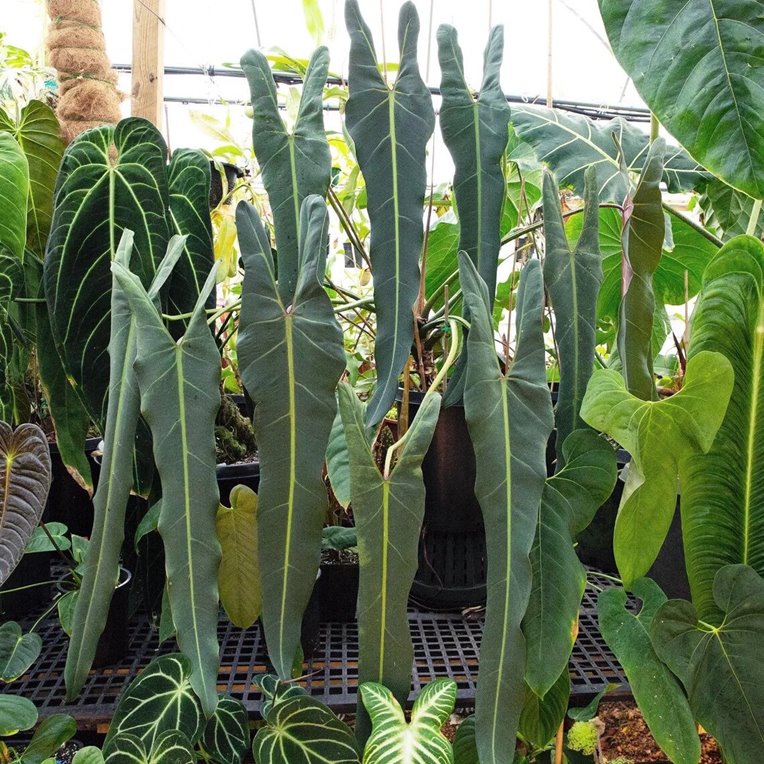
Contents
- Quick Overview
- Description and appearance
- 1. Growing habits
- 2. Size and growth rate
- 3. Leaves
- 4. Flowers and fruits
- Philodendron spiritus-sancti tissue culture (TC)
- Variegated Philodendron spiritus-sancti
- Similar plants
- Philodendron spiritus-sancti care
- 1. USDA hardiness zone
- 2. Temperature
- 3. Humidity
- 4. Light needs
- 5. Best soil mix
- 6. Watering
- 7. Fertilizer
- 8. Pruning and grooming
- 9. Repotting
- 10. Staking
- Philodendron spiritus-sancti propagation
- 1. Stem cutting propagation
- i. Soil propagation
- ii. Water propagation
- 2. Air layering
- Problems or issues
- Where to find Philodendron spiritus-sancti on sale
- Frequently asked questions (FAQs)
Quick Overview
- Scientific name: Philodendron spiritus-sancti
- Common names: Philodendron Santa Leopoldina or Philodendron Sanctum, or PSS
- Family: Araceae (aroids or arum family)
- Native habitat: Espirito Santo, Brazil
- Toxicity: All plant parts are toxic to cats, dogs, and humans since it has insoluble calcium oxalates. Patients will suffer from severe oral irritation and a burning sensation when chewed. Also, their lips, tongue, or mouth may swell and turn red. Other signs are swallowing difficulties, drooling, loss of appetite, etc.
- Care level: Easy to care for or low maintenance
Philodendron spiritus-sancti is an officially accepted Philodendron species that George S. Bunting described in 1987. But, early on, Bette Waterbury, one of the founders of the International Aroid Society (IAS), wrote about this plan in 1983. So, the capitalization of spiritus-sancti or omitting the hyphen is mislabeling it.
Its name came from ‘Spiritus Sanctus,’ which means Holy Spirit or what Christians call Holy Ghost.
Also, the common name Philodendron Santa Leopoldina isn’t a cultivar name. So, it is incorrect to write it as Philodendron ‘Santa Leopoldina’ as this would suggest it’s a cultivar.
Furthermore, since botanists first collected it around Santa Leopoldina town, the name isn’t accurate, and it is not unique to P. spiritus-sancti. Many other species from around Santa Leopoldina are similarly named. Such examples include P. curvilobum, P. atabapoense, and P. billietiae.
Lastly, some traders use this common name to hoodwink unsuspecting buyers to think that a Santa Leopoldina is always a P. spiritus-sancti. That is not the case. The latter is rare and expensive.
Description and appearance
Since the plant is rare, endangered, and nearly extinct, we must admit that not much information is available. Dr. Gonçalves and Emerson Salviani note that only six known specimens remain on a private farm owned by the Kautsky family (1). Why? Because of clearing the original habitat and turning it into cattle pastures.
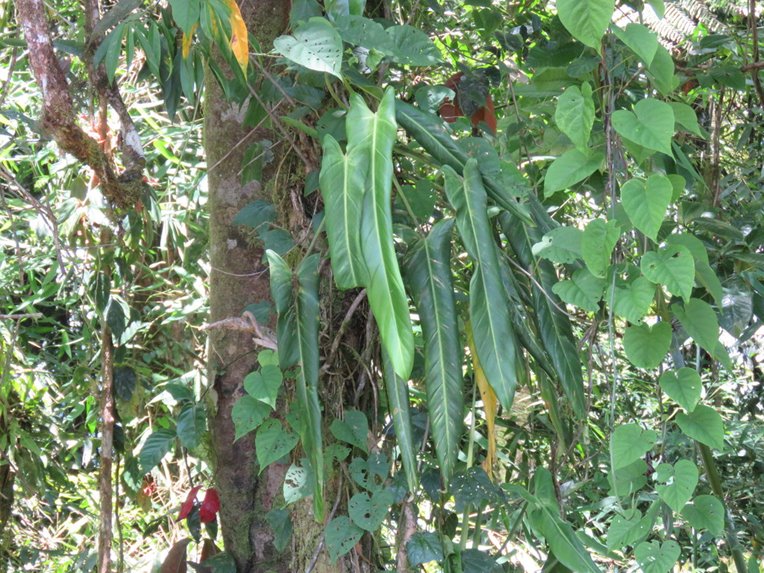
1. Growing habits
Philodendron spiritus-sancti is a tropical rainforest climbing hemiepiphyte native to Espirito Santo. To be precise, it is endemic to Domingos Martins, which neighbors Santa Leopoldina to the south.
A hemiepiphyte is a plant with a part of its lifespan as an epiphyte (growing on trees) and terrestrial plant (growing on the ground). Therefore, it may start from the tree and eventually send roots to the ground. Or, start from the ground, begin climbing trees, and finally break the linking stem, leaving only roots reaching the ground.
Usually, this plant grows at 2,132-2,824 feet (650 to 850 m) above sea level. But as noted, it’s nearly extinct, so you are unlikely to find it.
Lastly, like most of the other plants in this genus, it morphs, i.e., the juvenile plant has a distinctive appearance compared to the adult plant.
2. Size and growth rate
Philodendron spiritus-sancti can grow up to 65 feet (20m) tall in the wild. It is a relatively slow-growing plant. But at home, it will grow up to about 4-8 feet tall, and since it is a climber, you need to give it a stake or support.
3. Leaves
Like most other Philodendron species, the juvenile and mature leaves look different. In juvenile form, these leaves are oval-shaped.
On the other hand, mature Philodendron spiritus-sancti plants have elongated, triangular dull dark green leaves with a heart-shaped to arrow-shaped (cordate-sagittate) base, a paler underside, and wine-colored (vinaceous) margins. But some specimens may have a reddish underside, which some people refer to as the red form.
These papery to sub-leathery leaves have a slightly paler midrib and four primary lateral veins per side. They measure about 22.4-24.8 by 4.3-4.9 inches in length and width, with some cultivated plants having slightly broader leaves.
Lastly, the dull, dark green petioles are 13.7-23.6 inches long, making them nearly equal to shorter than leaves.
4. Flowers and fruits
As with other Philodendron species, the fertility period is short, and the spadix heats up to attract pollinating insects. Also, the female flowers’ receptive time doesn’t coincide with the male pollen release to prevent self-pollination.
This plant flowers mainly from November to December, but this time may vary. It produces 1-4 inflorescences per axil with a green-vinaceous peduncle that is reddish towards the apex, a spadix, and a spathe (bract).
The narrowly oval spathe is weakly constricted to separate the upper blade and lower tube. It’s greenish-vinaceous on the outside while the blade is whitish and tube reddish on the inside.
On the other hand, the spadix has a greenish female part on the lowest end (inside the tube) and a male cream section. This male part consists of the middle sterile and upper fertile
Lastly, the immature aggregated fruits (infructescence) are yellowish-green, and once they mature, they will have tiny, spindle-shaped whitish seeds.
Philodendron spiritus-sancti tissue culture (TC)
Tissue culture is a propagation method that uses a small plant tissue, a few cells, or even a cell to clone an exact plant. The growth occurs in a sterile medium with hormones and nutrients necessary to encourage growth.
So far, Thailand has produced a Philodendron spiritus-sancti tissue culture, available on sale. This method allows for mass production and requires a smaller space. Also, plants are free of disease.
But some people have a reservation since it lacks genetic variability like a seed-grown plant. Also, the resultant plants do look a little different.
We don’t have any reservations with such plants, and if you don’t prefer them, you can ask the vendor which one they have.
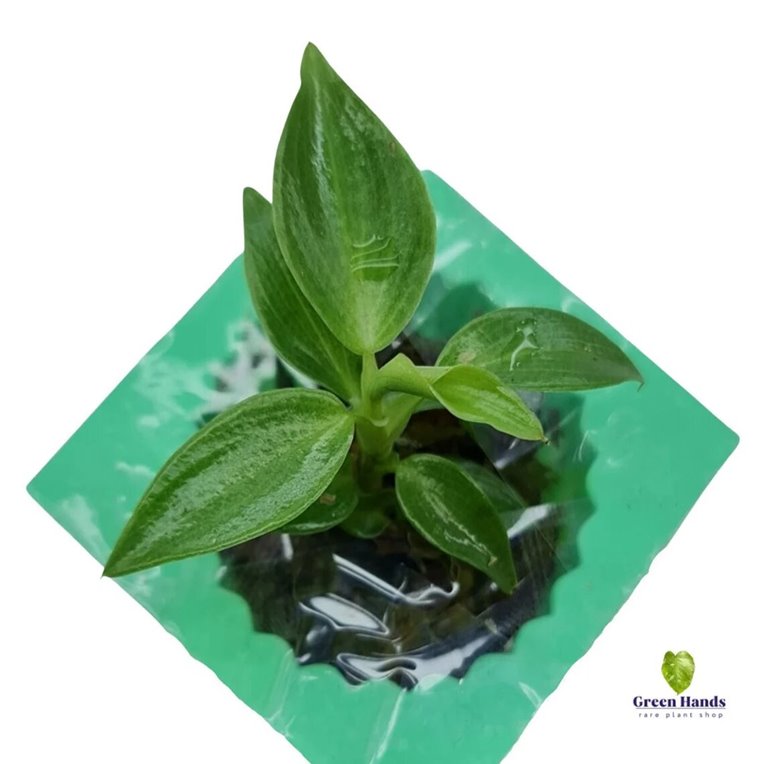
Variegated Philodendron spiritus-sancti
There is a variegated Philodendron spiritus-sancti, i.e., a white variegated houseplant. So far, only Redleaf Exotics has it. A while back, they were able to grow this plant until it flowered and had fruits.
The variegated plant grew from one of the thousands of seeds they planted, making it a random, mostly likely chimeral kind of variegation and specifically, sectorial. Such variegations are unstable, unpredictable, and may revert.
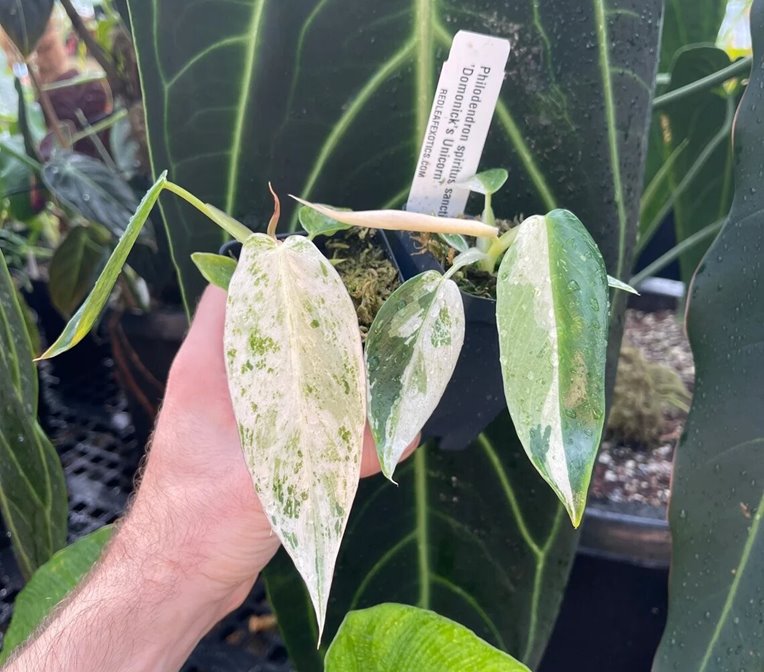
Similar plants
Its vegetative features resemble Philodendron hastatum, P. curvilobum, and other species. But You can distinguish it from these two considering the much-elongated front lobe that is four times longer than the posterior lobes.
Philodendron spiritus-sancti care
Contrary to what many people claim, Philodendron spiritus-sancti is an easy-to-care-for houseplant. It needs a warm (60-80°F), humid area with bright indirect light. Water it when the top few inches feel dry and ensure the soil drains well, is airy, and rich in organic matter.
That is not all. Don’t forget to feed it monthly with a liquid houseplant fertilizer, prune it as necessary and repot it after 2-3 years. Also, please give it a climbing place.
Here is more detail on care:
1. USDA hardiness zone
The USDA hardiness zone for P. spiritus-sancti is 10-12. It isn’t frost-hardy, and freezing temperatures will kill it. Only in these zones can it grow all year outdoors.
2. Temperature
The ideal temperature should be 60 to 80 degrees Fahrenheit (15.6-26.7°c) which is within the limits of what Domingos Martins in Brazil has, i.e., 57°F to 84°F, hardly going below 52°F or more than 90°F.
Avoid temperatures below 55°F, sudden changes, cold drafts, or placing your plant near a cold or heat-emitting source like AC or room heating system vents.
3. Humidity
P. spiritus-sancti loves high humidity, 70% to 80%. But it can still grow at lower, such as 50%, if you keep it well hydrated.
For very low humidity, raise it by misting your plant, having a pebble tray, or moving it to more humid rooms like your bathroom or kitchen.
However, to ensure constant high humidity, buy a humidifier.
4. Light needs
Please place it in a spot where it receives bright, indirect light for about 12 to 13 hours. If on the East facing window, 2 to 3 hours of early morning sun is ok. But you must avoid the hot midday or afternoon direct light as it may cause sunburn characterized by paler or bleached leaves with crispy brown tips and edges.
On the other hand, low light will slow growth, and if too low, your plant may have paler, yellowish smaller leaves or be leggy. In this case, buy grow lights with a light intensity of 5000 to 25000 lux (500-5000 footcandles).
For brand, there are many. You can go for Briignite LED Grow Light Bulb. It is affordable and has sun-like full spectrum light. Also, it has a long lifespan of up to 50,000 hours.
5. Best soil mix
The best soil mix for Philodendron spiritus-sancti should be well-drained, aerated, and high in organic matter. A slightly acidic to neutral 5.5-7.3 pH works the best.
You are free to buy an aroid mix from places like Etsy.com or make yours. Add perlite, bark chips, peat moss, and compost (or worm castings) to your potting mix to create an aroid mix. Exact ratios don’t matter so long as it’s chunky, well-draining, and holds moisture without being soggy.
Lastly, avoid heavy or compacted soils as they are likely to result in overwatering and root rot.
6. Watering
Water your plants when the potting mix’s top 2-3 inches dries. It may be after a few days to a week in the growing months or biweekly in the non-growing.
However, you must feel the soil, i.e., when the potting mix feels dry up to the 1st knuckle or your soil moisture meter reading is in the dry zone. XLUX is an excellent brand to buy.
Please, don’t follow a watering schedule because water needs changes with conditions, kind of potting mix or pot, plant size, etc.
If not high in fluoride, chlorine, or salts, you can use tap water. But if high, go for rainwater, reverse osmosis, or distilled water. For water high in chlorine alone, place it in an open container overnight to dissipate the chlorine.
Lastly, slowly pour water on the soil until excess flows from drainage holes when watering. Then, discard whatever collects on the saucer after 20 minutes.
7. Fertilizer
Philodendron plants are heavy feeders since they grow fast. But this specific species is a slow grower. So, we recommend feeding your plant once a month with a balanced, liquid houseplant fertilizer at ¼ to ½ recommended strength during grow months only. If it has a low N-P-K ratio or is less concentrated, you can increase the frequency. Miracle-Gro Indoor Plant Food (Liquid) is such a good pick.
Alternatively, use slow-release balanced fertilizers for indoor houseplants like Osmocote Smart-Release Plant Food Plus Outdoor & Indoor. Start applying in early spring and follow instructions.
8. Pruning and grooming
Pruning will involve cutting any damaged, dead (including entirely yellow or browned) or diseased leaves. Use sterilized gardening shears.
Also, you can clean dusty or dirty leaves, and if you want to control growth, you can cut the stems.
9. Repotting
Repotting is after 2-3 years or if rootbound, i.e., your plant has outgrown the pot, and roots are spiraling inside the pot and growing from drainage holes.
Select a pot 2-3 inches wider in diameter, and do it in growing months unless extremely necessary.
10. Staking
Since it grows slowly, you may not see the need for support while it is young. But with time, it will grow larger. So, we recommend that you give and train it on a moss pole, totem, trellis, or any other climbing surface. It will reward you with those large, long leaves.
Philodendron spiritus-sancti propagation
Philodendron spiritus-sancti propagation is mainly by stem cutting or air layering. But you can use seeds if you are lucky to find them. Redleaf Exotics grew this plant until it flowered, had fruits, and successfully grew the seeds, getting even some variegated plants. So, it is not impossible.
To use a stem Philodendron spiritus-sancti cutting, it must have at least a node (the knobby part where aerial roots grow or leaves attach). Also, you need to know that it takes longer for this plant to root, a reason why it’s rare and expensive.
We will look at stem cutting propagation and mention one or two things on air layering. While a viable method, Philodendron spiritus-sancti seeds are rare and hard to find. So, this method is less likely the probable one you will use.
1. Stem cutting propagation
This method requires a stem cutting with at least a node. You cannot propagate this plant with a nodeless stem, aerial root, or leaf with the petiole.
Additionally, you can propagate your cutting in water or soil. But since it doesn’t root easily and has some chances of failure, why not use soil?
Let us look at stem cutting propagation in soil and comment on those opting for the water method.
i. Soil propagation
Soil propagation is our preferred method. It is faster than water propagation, and your plant will get nutrients from the soil. Also, it will not suffer much transplant shock.
What you need
- Potting mix or sphagnum moss
- Nursery pot
- Pruning shears
- Rubbing alcohol (70-90%) for sterilizing your scissors
- Rooting hormone (optional). If you don't have one, buy Clonex Rooting Gel. It has a water-based formulation and has nourishing nutrients besides the rooting hormone.
- Plastic bag (optional)
Note: If you choose sphagnum moss, first soak it in water for 20-25 minutes, then squeeze it to get rid of excess water. Afterward, don’t water it. Instead, mist it when it begins to dry.
Steps to follow
- Select a healthy, mature stem with at least two nodes and cut it using sterilized pruning shears below the lower node. If it has more than two leaves, remove the lower ones.
- Apply your rooting hormone on the cut end. It will speed rooting and prevent decay.
- Fill your pot with your potting mix, then make a hole and plant your cutting, ensuring at least a node is under the soil. Then press more potting mix on the stem to ensure it remains upright.
- Thoroughly water your cutting until excess water flows from drainage holes. If you have a saucer, discard any that collects in it.
- Cover your plant with your transparent plastic bag leaving a small opening to help lock humidity. It is only necessary if you have low humidity. Otherwise, you don’t need it.
- Place your plant in a warm area with bright, indirect light.
- Routinely remove the plastic bag to give your plant time to breathe. Also, mist the potting mix if it begins to dry.
When the roots are long enough, and you see new growth, you can transplant the cutting.
ii. Water propagation
This method will allow you to see roots grow but take longer. Also, your plant will suffer more shock when you transplant it and will not get nutrients present in the soil.
After step two above, dip the cutting in a water-filled jar. Ensure at least a node remains inside the water but not the leaves. Then after every 3-4 days or when the level goes down, change the water.
2. Air layering
Air layering involves wrapping moist sphagnum moss on a node of the stem you target for propagation while still attached to the mother plant. Keep the sphagnum moist and ensure it allows for air circulation.
After some time, it will begin growing roots. Once they are long enough, cut and transplant the cutting its growth pot.
This method will guarantee you a higher success rate. But not everyone wants to see sphagnum moss wrapped on their houseplant.
Problems or issues
There are no issues or problems specific to this plant species, except the usual ones that affect any other Philodendron.
- Pests: Your plant may have thrips, scale insects, mites, mealybugs, and aphids, but they are uncommon indoors. A 10X magnifying glass should help you see them. If you notice any, use insecticidal soaps, horticultural oil sprays, or neem oil to control them.
- Disease: Brown or black spots that may be sunken or have a yellow halo are the signs of fungal or bacterial leaf spots or blights. To prevent them, practice good sanitation and isolate new plants.
- Root rot: It’s a common problem for people who overwater their plant or have a potting mix that doesn’t drain. Roots will be mushy and black or brown. Repot your plant, cutting any decayed bits.
- Leaves are turning yellow: You likely overwater your plant. Other reasons are too little or much light, underwatering, cold drafts, and heat stress. But in rare instances, it may be nutritional deficiencies.
- Leaves are browning or have brown tips and edges: Brown tips and edges indicate sunburn, low humidity, heat stress, underwatering, and fertilizer burns. Also, other temporary issues like repotting shock or rootbound may be a reason. It may be overwatering if you see brown splotches, while sudden browning indicates cold damage or drafts.
- Leaves are curling: Your plant is losing too much moisture or wants to protect itself. Reasons are underwatering, too much light, low humidity, heat stress, root rot, or anything that causes lots of water loss or stops roots from absorbing water like fertilizer burns.
- Drooping and wilting: It happens when plant cells don’t have enough water to keep them rigid. The reasons are similar to those for leaf curling.
Where to find Philodendron spiritus-sancti on sale
If you are looking for Philodendron spiritus-sancti, start with Etsy.com and eBay. These marketplaces have vendors from the US, Canada, Australia, the UK, etc, or will ship to you. Also, their prices are competitive, especially on Etsy.com.

At Etsy.com, buy from Red Leaf Exotics, Succulents EmpireLLC, BlomstreGardens, FloralEXotica, or HTHousePlants. There are a few other credible vendors too.
Secondly, find vendors on Facebook and Instagram. Here you will find many people across the globe. But only select trusted rare plant vendors and collectors. You can judge them by looking at the feedback they receive and comments.
The other places to buy this plant are Rare Plant Shop in the UK which sells it for £650, Redleaf Exotics (Morison, TN) selling at USD 900, and Fantastic Gardens Hawaii for a whopping $12000. People in the Philippines will find it at the Arid and Aroids gardening center (Silang, Cavite).
If you still haven’t found this plant, use search engines. For instance, you can google “Philodendron spiritus-sancti for sale” to see what recommendations you get.
Warning:
Not every plant labeled Philodendron Santa Leopoldina is a P. spiritus-sancti. So, avoid any plants described as fast-growing or have longer internodes. Remember even a juvenile Philodendron billietiae does resemble it. So, stick to trusted vendors with many positive reviews.
Frequently asked questions (FAQs)
Yes. Philodendron spiritus-sancti is a super rare and extremely hard-to-find houseplant that only a handful of rare plant collectors and sellers have. None of the big box stores, your local tropical specialty plant stores, or large-scale horticultural growers have it. To confirm the rarity, this plant was stolen sometime back (2020) from San Diego Botanic Garden.
The Philodendron spiritus-sancti price ranges from $500 to $6000 depending on the size and where you buy it, with some vendors selling it as high as $12,000 or more. A wet stick (leafless node) or unrooted cutting may cost you about $500-$800, a small plant $900-$1,500, while an established larger plant sells at $1,600 to $5,000.
Philodendron spiritus-sancti is expensive because it’s nearly extinct (you cannot find it in the wild), and only a few people have it. Also, it grows slowly, and propagation is more challenging and takes longer, meaning you cannot quickly reproduce it.
The other reason is its high demand, perhaps due to the charming appearance. But with the availability of tissue culture plants, we hope prices may eventually go low. But that won’t be any day soon.
I am told prices for Philodendron spiritus-sancti range from ₱350,000 to ₱600,000 or an equivalent of $6,723-$11,525. But this is for a larger plant. Smaller ones will probably cost less, including the tissue culture plants from Thailand.
As a rare and nearly extinct plant, finding Philodendron spiritus-sancti seeds on sale is not easy if not impossible. So, we don’t encourage buying them since they are not likely to be genuine.

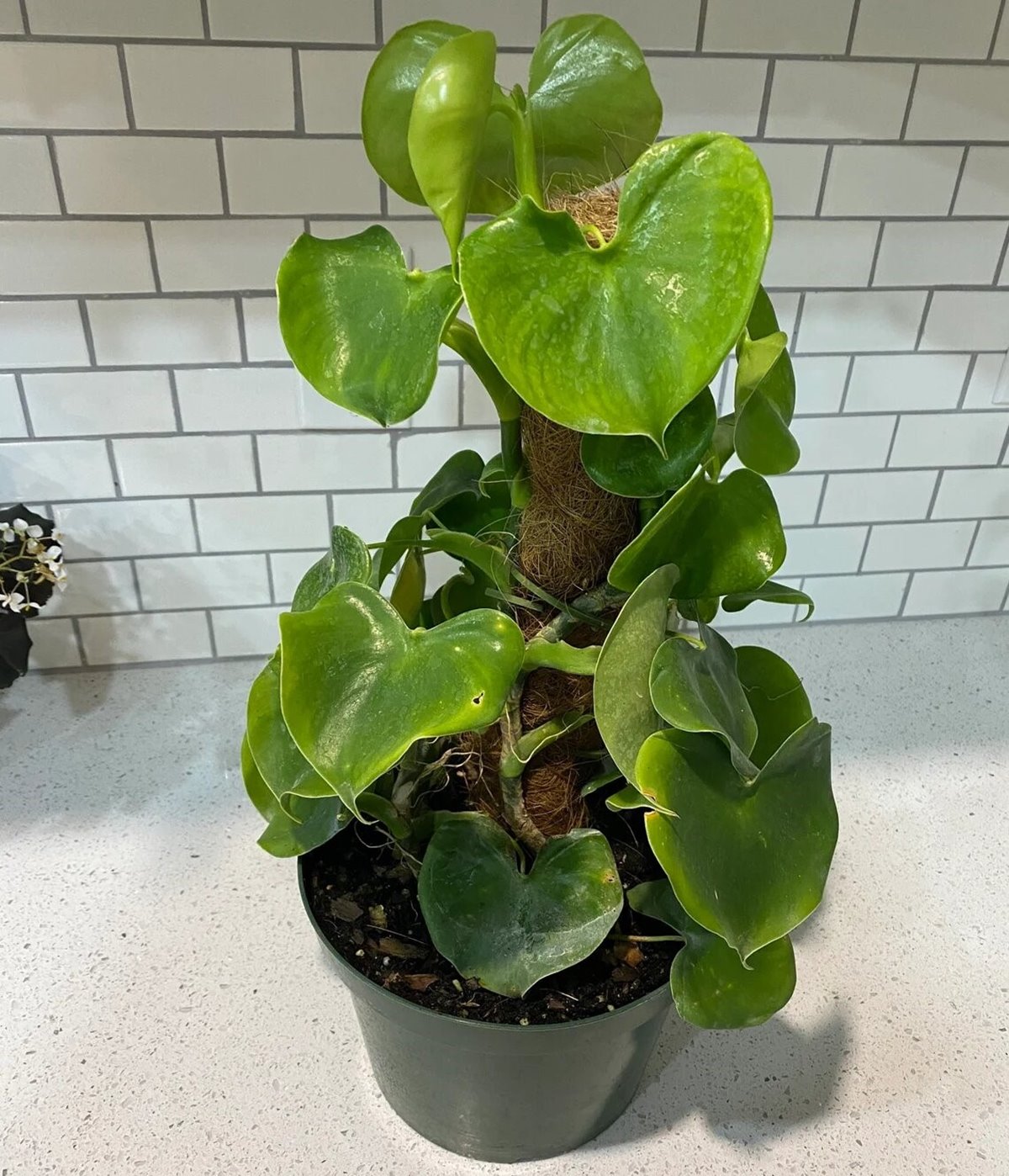
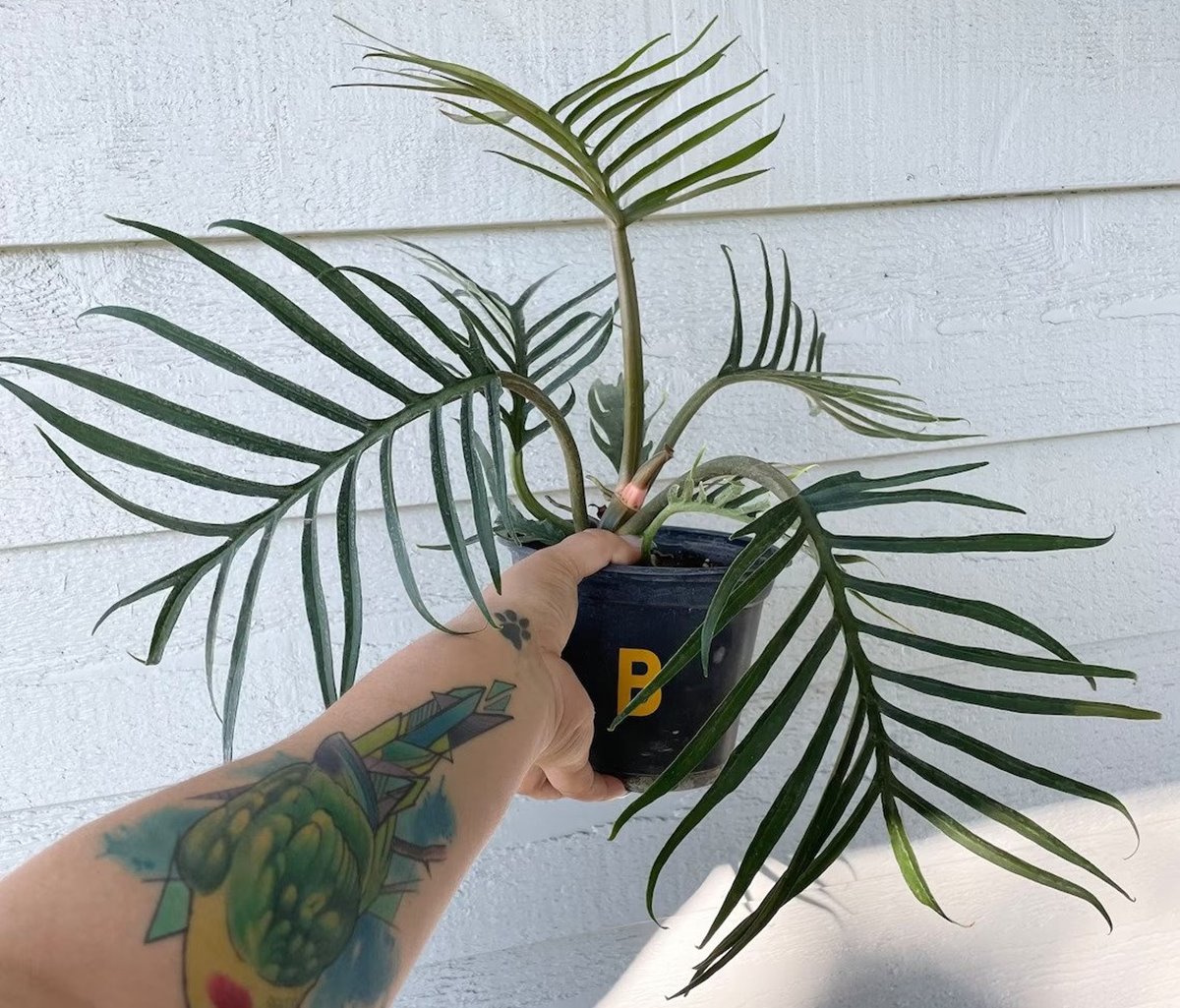
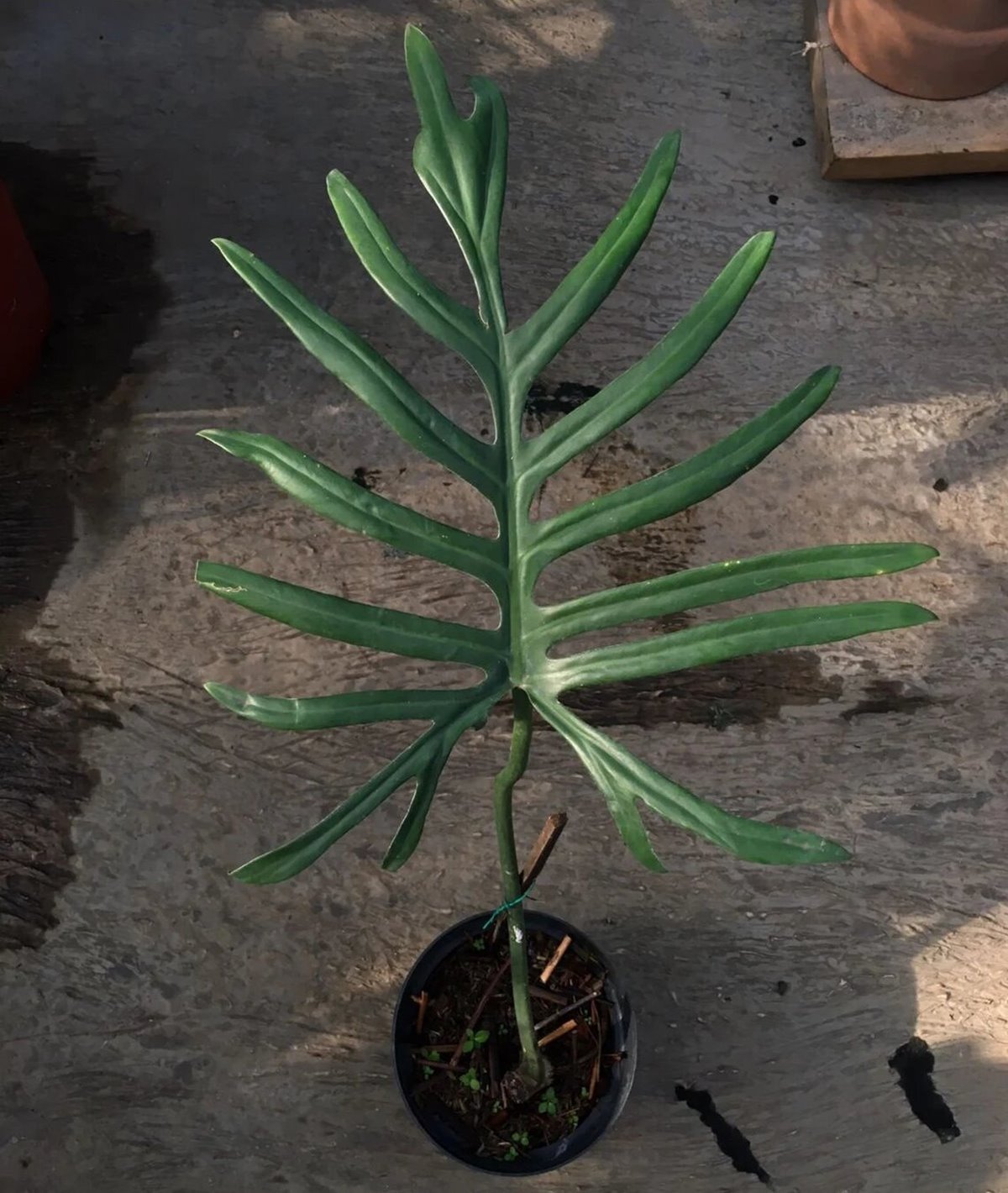

Leave a Reply